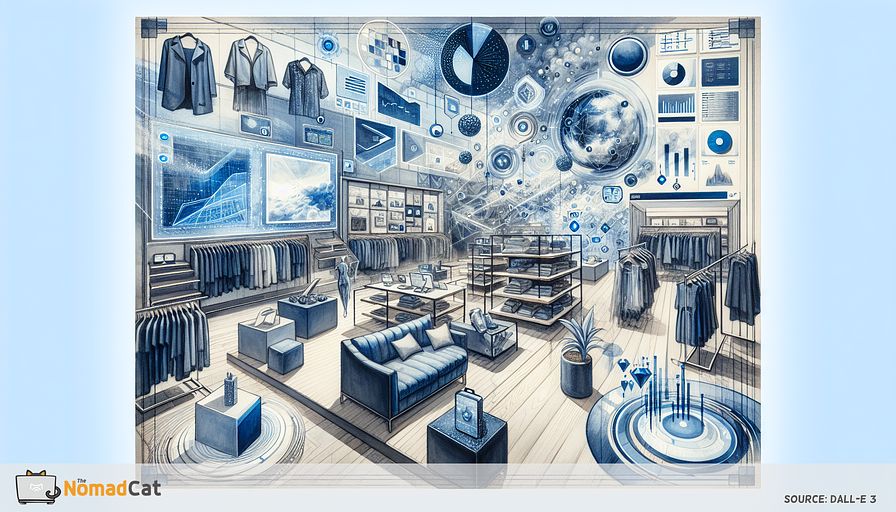Abstract:
Augmented reality (AR) is reshaping the retail landscape by offering immersive shopping experiences that blend the digital and physical worlds. Retailers are leveraging AR to enhance customer engagement, enabling shoppers to visualize products in their own space before making a purchase. This technology facilitates virtual try-ons, from clothes to furniture, helping consumers make informed decisions. Moreover, AR-driven navigation tools within stores guide customers to their desired products effortlessly, improving overall satisfaction. The data gathered through AR interactions provides valuable insights for personalized marketing and inventory management, optimizing both the supply chain and the customer journey. As AR technology becomes more accessible, its integration into the retail sector signifies a shift towards more interactive and personalized shopping experiences, setting a new standard for customer service and operational efficiency.
Introduction to AR in retail
Augmented Reality (AR) is stepping into the spotlight within the retail world, merging digital innovation with traditional in-store experiences. By overlaying digital information onto real-world environments, AR is transforming how consumers interact with products and make purchasing decisions. This cutting-edge technology enriches the shopping experience, offering a new blend of convenience and interactivity.
Shoppers can now visualize products in their homes, try on virtual clothes, and explore intricate details before making a purchase—right from their smartphones. This amalgamation of the digital and physical realms is not just a fleeting trend; it's a substantial shift shaping the future of retail. AR doesn't merely add a digital layer; it enhances customer engagement and profoundly impacts how businesses in the retail sector operate and flourish.
As we embark on this journey through AR’s facets in shopping, we will explore its immense potential to elevate customer experience, drive sales, and provide unprecedented data insights. Get ready to delve into how AR is making waves in the retail landscape, redefining what's possible for both consumers and retailers alike.
Enhancing customer engagement
AR is revolutionizing customer engagement by enabling shoppers to see products in their own spaces before hitting the buy button. This visual and interactive aspect of AR makes the shopping experience far more vibrant and enticing. It's not just about seeing a product; it's about experiencing it within the comfort of one's environment, blurring the lines between digital and physical shopping.
Imagine browsing furniture and being able to position a virtual sofa in your living room, showcasing how it complements the space. This dynamic approach allows customers to make informed decisions, fostering a sense of confidence and satisfaction in their purchases. AR brings a hands-on feel to online shopping, bridging the gap between e-commerce and brick-and-mortar stores in a unique way.
Moreover, this technology personalizes the shopping journey. By tailoring experiences to individual preferences, AR makes each interaction more meaningful. Whether it's trying on makeup shades tailored to your skin tone or placing a new coffee table in your kitchen, AR brings a layer of customization that traditional shopping methods can't offer. This personalization makes customers feel valued and understood.
The interactive nature of AR also holds a fun and engaging element, transforming routine shopping into an exciting adventure. Customers are more likely to spend time exploring products and discovering new items when they are presented in an engaging format. This increased engagement not only improves customer satisfaction but also boosts sales and brand loyalty.
AR is more than just a tech novelty; it's creating a richer, more enjoyable shopping experience. By blending the physical and digital shopping realms, it elevates customer interactions, making shopping an experience rather than a task.
Virtual try-ons
One of the most exciting features of AR technology is its ability to offer virtual try-ons. This innovative function is changing the game for online shopping, allowing consumers to preview items such as clothing, accessories, and even furniture in a highly realistic manner. By providing a virtual fitting room, AR addresses one of the biggest challenges of online shopping: the inability to physically interact with the products before purchase.
Shoppers can now use their smartphones or other devices to see how a dress fits, how a pair of glasses suit their face, or how a piece of furniture looks in their living room. This capability not only makes the shopping experience more interactive but also significantly reduces the uncertainty and hesitance that often accompany online purchases. Customers can make more confident and informed decisions, leading to higher satisfaction and fewer returns.
Virtual try-ons bring several advantages for both consumers and retailers:
- Realistic previews: AR provides a lifelike representation, allowing shoppers to get an accurate feel of how the product will look in real life.
- Convenience: By enabling try-ons from the comfort of home, AR eliminates the need for time-consuming trips to physical stores.
- Enhanced decision-making: With a realistic preview, buyers can better assess fit, color, and style, thus making more informed purchasing choices.
- Reduced return rates: As customers are clearer about their choices, the likelihood of returns is minimized, saving time and cost for retailers.
Additionally, virtual try-ons contribute to a personalized shopping experience. By utilizing AR, brands can tailor suggestions based on the customer's preferences and past interactions, making every shopping journey unique and personal. This customized approach resonates well with consumers, making them feel appreciated and understood.
Furthermore, virtual try-ons offer an element of fun. Trying on different outfits or testing various furniture arrangements can turn the shopping process into an enjoyable activity. This interactive nature keeps customers engaged, increasing the time they spend on a retailer's platform and enhancing overall brand loyalty.
The impact of virtual try-ons is far-reaching. It not only transforms how shoppers interact with products but also aligns closely with the evolving expectations of modern consumers who seek convenience, personalization, and interactivity. AR's virtual try-on capability is a revolutionary tool, bridging the gap between the physical and digital shopping worlds, making the entire process smoother and more enjoyable.
AR-driven in-store navigation
Finding your way around a store can sometimes be a hassle, but AR technology is here to turn that around. With AR-driven in-store navigation, customers can now effortlessly locate the products they're after, making their shopping trips more efficient and enjoyable. This tech-savvy guide overlays digital directions onto the real world using smartphones or AR glasses, providing a seamless and intuitive route through the store.
This innovative approach offers several benefits:
- Ease of use: By simply pointing their cameras around the store, shoppers can receive step-by-step directions to their desired items, much like a GPS for indoor environments.
- Time-saving: Efficient navigation means less time wandering aisles and more time purchasing. This quick and straightforward route to products saves valuable time for customers.
- Enhanced shopping experience: The ease and efficiency of AR navigation can lead to higher customer satisfaction, making the shopping journey more pleasant.
- Interactive elements: By adding interactive elements along the way, such as special offers or additional product information, AR can turn a simple shopping trip into a more engaging and informative experience.
AR-driven navigation not only benefits customers but also retailers. By understanding customer movement patterns, stores can optimize product placement, manage foot traffic, and create more effective store layouts. This data-driven insight into consumer behavior helps in refining marketing strategies and improving overall business operations.
Furthermore, this technology can guide customers to discover new products they might have otherwise missed, increasing opportunities for upselling and cross-selling. The result is a win-win scenario where shoppers enjoy a more engaging and efficient experience, while retailers see improved sales and customer loyalty.
In conclusion, AR-driven in-store navigation is revolutionizing the way we shop by blending convenience with state-of-the-art technology. Whether you’re in a large department store or a modest boutique, AR can guide you effortlessly, making shopping less of a chore and more of an adventure.
Data insights and personalized marketing
Augmented Reality (AR) isn't just a gimmick for enhancing the shopping experience; it also serves as a treasure trove of data. Through AR interactions, retailers can gather invaluable insights into customer behaviors and preferences. This wealth of information paves the way for highly personalized marketing strategies, allowing businesses to connect with their audience on a much deeper level.
When shoppers engage with AR features, every interaction—whether it's a virtual try-on or an in-store navigation search—produces data points that create a comprehensive picture of customer preferences. Retailers can analyze these patterns to identify trends, popular products, and even areas where customers frequently face hurdles. This data-driven approach enables them to fine-tune their offerings and create targeted promotions that resonate with individual customers.
Understanding customer behavior
AR technology helps retailers decode the complexities of shopping habits. By tracking what products customers are interested in and how they interact with them, businesses can better understand what drives purchasing decisions. Factors like the time spent on a virtual product, the frequency of AR interactions, and the items returned after purchase offer vital clues into customer behavior:
- Product preferences: Data on frequently viewed or tried-on items helps identify popular products and styles, guiding inventory decisions.
- User engagement: Metrics on how users engage with AR features can reveal which elements are most effective, optimizing future AR investments.
- Customer pain points: Insights into common issues customers face can help improve the overall shopping experience, reducing barriers to purchase.
Shaping personalized promotions
The data harvested from AR interactions empowers retailers to deliver personalized marketing efforts. By tailoring offers and promotions based on a customer's history and preferences, businesses can create a more personalized and engaging shopping experience. This targeted approach not only enhances customer satisfaction but also drives sales:
- Customized offers: Special promotions or discounts on items that a customer has shown interest in can significantly increase purchase likelihood.
- Tailored recommendations: By analyzing past AR interactions, retailers can suggest products that align with a customer's tastes, enhancing the relevance of recommendations.
- Enhanced loyalty programs: Personalized perks and rewards based on AR data can foster greater customer loyalty and repeat business.
Improving the customer journey
AR data insights are not solely beneficial for marketing; they also improve the entire customer journey. By understanding what customers want and how they shop, retailers can create a seamless, enjoyable shopping experience. Optimized store layouts, intuitive navigation systems, and better customer service are just a few ways AR data can enhance the journey from start to finish.
In a nutshell, the integration of AR technology in retail doesn't just elevate the shopping experience—it equips retailers with powerful data insights. These insights transform how businesses understand their customers, enabling personalized marketing strategies that foster deeper connections and drive success. With the potential to fine-tune every aspect of the customer journey, AR data is a game-changer in creating a more responsive, customer-centric retail environment.
Optimizing inventory management
Augmented Reality (AR) is not only revolutionizing customer engagement but also enhancing behind-the-scenes operations like inventory management. By harnessing AR-driven data, retailers can achieve more precise inventory tracking and streamline supply chain processes, ensuring that products are always in stock and accessible when customers need them.
Accurate inventory management is crucial for maintaining customer satisfaction and operational efficiency. AR technology contributes to this by providing real-time data on product location, stock levels, and movement within the store or warehouse. This real-time tracking capability minimizes the likelihood of stockouts, reducing the frustration customers feel when desired items are unavailable. By facilitating better stock visibility, AR enables retailers to maintain optimal inventory levels and meet customer demand more effectively.
Enhanced tracking and visibility
AR tools can be integrated within inventory management systems to offer enhanced tracking and visibility. Using AR-enabled devices, staff can quickly scan products and access detailed information about their stock status, location, and history. This high level of transparency helps identify discrepancies promptly and take corrective actions, thus maintaining an accurate inventory:
- Real-time updates: Keep track of inventory changes as they occur, ensuring up-to-date and accurate stock information.
- Efficient restocking: Quickly identify low stock items and prioritize restocking to prevent shortages.
- Error reduction: Minimize human error in inventory counts with AR-guided procedures and automated data capture.
Simplifying supply chain operations
AR's impact extends beyond the store floor to the broader supply chain. By leveraging AR data, retailers can fine-tune logistics and distribution processes. Real-time insights into stock levels help suppliers make informed decisions about order quantities and delivery schedules, ensuring that products are restocked efficiently and punctually. This seamless integration between AR and supply chain management reduces lead times and helps maintain a steady flow of inventory:
- Optimized order management: Use AR-driven insights to determine the perfect timing and quantity for reordering stock.
- Improved supplier coordination: Enhance communication and coordination with suppliers by sharing accurate inventory data.
- Cost reduction: Streamline supply chain operations to reduce excess inventory and associated holding costs.
Data-driven decision making
AR technology empowers retailers to make data-driven decisions that enhance inventory management. With detailed analytics on sales trends, product movement, and customer preferences, businesses can forecast demand more accurately and adjust their inventory strategies accordingly. This proactive approach not only helps in maintaining a well-balanced stock but also optimizes the overall cost of inventory management:
- Predictive analytics: Use historical data to predict future demand and adjust stock levels preemptively.
- Seasonal adjustments: Align inventory with seasonal trends and promotions, preventing overstock or understock situations.
- Strategic planning: Formulate long-term inventory strategies based on comprehensive AR insights and analytics.
In essence, AR is transforming inventory management into a more efficient, accurate, and data-driven process. By integrating AR technology, retailers can not only enhance the customer experience but also ensure that their operations run smoothly, making sure products are always available when needed. This innovative approach to inventory management is setting the stage for a more responsive and efficient retail industry.
Future prospects and accessibility
Looking ahead, the potential for AR in retail is both promising and exciting. As this technology continues to evolve, we can expect to see even more widespread accessibility and deeper integration into the shopping experience. AR is set to redefine what personalized and interactive shopping looks like, raising the bar for customer service and operational efficiency.
A significant aspect of the future of AR is improved accessibility. As AR technology becomes more common and affordable, it will be available to a broader audience. Innovations in hardware and software will make it easier for retailers to implement AR features in their stores and online platforms. This widespread adoption will democratize the benefits of AR, allowing even small businesses to leverage its power to enhance customer engagement.
Deeper integration of AR into various aspects of retail will also drive significant advancements. We can anticipate more sophisticated virtual try-ons, where the accuracy and realism of product previews will be nearly indistinguishable from real life. These advancements will further reduce the gap between online and in-store shopping experiences, offering customers the best of both worlds.
Interactive shopping experiences
As AR technology progresses, it will unlock new possibilities for interactive shopping experiences. Future developments might include advanced AR-driven gamification elements, where customers can engage in interactive scavenger hunts or virtual rewards programs while they shop. These fun and immersive experiences will not only capture customer interest but also encourage repeat visits and increased engagement with the brand:
- Gamified shopping: Incentivize customers through AR-based games and challenges within the store.
- Virtual rewards: Offer personalized rewards based on AR interactions and shopping behavior.
- Augmented social shopping: Enable customers to share their AR shopping experiences with friends, adding a social layer to the experience.
Enhanced personalized service
The future of AR in retail is also geared towards delivering even more personalized service. By using data from AR interactions, retailers will be able to craft highly tailored shopping journeys. Customers will receive bespoke recommendations, customized promotions, and unique in-store experiences that cater precisely to their preferences and needs. This level of personalization will empower retailers to build stronger, more meaningful relationships with their customers:
- Tailored recommendations: Provide suggestions based on individual tastes and past AR interactions.
- Customized promotions: Offer exclusive deals and discounts that match each customer's buying habits.
- Personalized in-store assistance: Use AR to guide customers through the store with personalized recommendations along the way.
In summary, the future of AR in retail promises a realm of boundless possibilities, from making high-tech features more accessible to every consumer to delivering deeply personalized and interactive shopping experiences. As AR continues to grow and improve, it will significantly enhance the retail landscape, setting a new standard for customer service, engagement, and satisfaction. The shift towards a more responsive and immersive retail environment is well underway, and AR stands at the forefront of this exciting transformation.
You might be interested by these articles:
- Revolutionizing Retail with Augmented Reality
- Enhancing The Retail Experience Through AR
- Augmented Reality: Revolutionizing Retail and Reducing Returns





